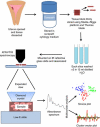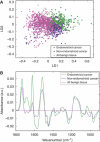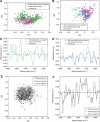Infrared spectroscopy with multivariate analysis to interrogate endometrial tissue: a novel and objective diagnostic approach
- PMID: 21326237
- PMCID: PMC3048205
- DOI: 10.1038/sj.bjc.6606094
Infrared spectroscopy with multivariate analysis to interrogate endometrial tissue: a novel and objective diagnostic approach
Abstract
Background: Endometrial cancer is the most common gynaecological malignancy in the United Kingdom. Diagnosis currently involves subjective expert interpretation of highly processed tissue, primarily using microscopy. Previous work has shown that infrared (IR) spectroscopy can be used to distinguish between benign and malignant cells in a variety of tissue types.
Methods: Tissue was obtained from 76 patients undergoing hysterectomy, 36 had endometrial cancer. Slivers of endometrial tissue (tumour and tumour-adjacent tissue if present) were dissected and placed in fixative solution. Before analysis, tissues were thinly sliced, washed, mounted on low-E slides and desiccated; 10 IR spectra were obtained per slice by attenuated total reflection Fourier-transform IR (ATR-FTIR) spectroscopy. Derived data was subjected to principal component analysis followed by linear discriminant analysis. Post-spectroscopy analyses, tissue sections were haematoxylin and eosin-stained to provide histological verification.
Results: Using this approach, it is possible to distinguish benign from malignant endometrial tissue, and various subtypes of both. Cluster vector plots of benign (verified post-spectroscopy to be free of identifiable pathology) vs malignant tissue indicate the importance of the lipid and secondary protein structure (Amide I and Amide II) regions of the spectrum.
Conclusion: These findings point towards the possibility of a simple objective test for endometrial cancer using ATR-FTIR spectroscopy. This would facilitate earlier diagnosis and so reduce the morbidity and mortality associated with this disease.
Figures





References
-
- Baker M, Gazi E, Brown M, Shanks J, Clarke N, Gardner P (2009) Investigating FTIR based histopathology for the diagnosis of prostate cancer. J Biophotonics 2: 104–113 - PubMed
-
- Bokhman JV (1983) Two pathogenetic types of endometrial carcinoma. Gynecol Oncol 15: 10–17 - PubMed
-
- D'Angelo E, Prat J (2010) Uterine sarcomas: a review. Gynecol Oncol 116: 131–139 - PubMed
-
- German MJ, Hammiche A, Ragavan N, Tobin MJ, Cooper LJ, Matanhelia SS, Hindley AC, Nicholson CM, Fullwood NJ, Pollock HM, Martin FL (2006) Infrared spectroscopy with multivariate analysis potentially facilitates the segregation of different types of prostate cell. Biophys J 90: 3783–3795 - PMC - PubMed
Publication types
MeSH terms
LinkOut - more resources
Full Text Sources
Miscellaneous

